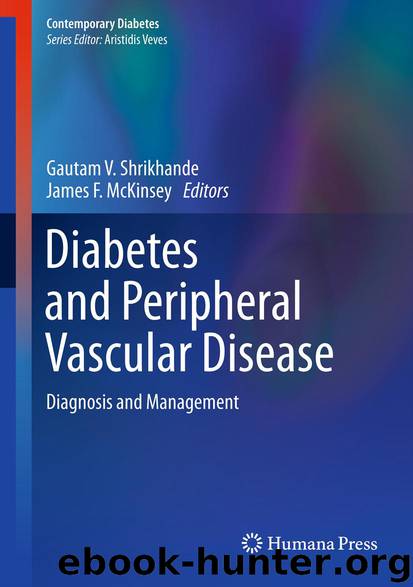Diabetes and Peripheral Vascular Disease by Gautam V. Shrikhande & James F. McKinsey

Author:Gautam V. Shrikhande & James F. McKinsey
Language: eng
Format: epub
Publisher: Humana Press, Totowa, NJ
Review of the diagnostic angiography is performed and the vascular specialist determines if the patient’s clinical presentation and pattern of disease are consistent with candidacy for endovascular therapy.
Crossing Lesions
Systemic heparin is administered, and an arterial sheath (of sufficient caliber to subsequently permit introduction of devices for treatment) is introduced over a stiff wire. Once therapeutic levels of anticoagulation are achieved, using selective catheter and wire combinations, wire access is obtained across the diseased arterial segment. Although a number of wire and selective catheter combinations may be used, the authors routinely use a hydrophilic 0.035″ angled wire and 5 French angled catheter during the initial attempt to cross lesions. Based on the interventionalist’s preference and experience, different combinations of wire diameter (0.014″, 0.018″, 0.035″), stiffness, and angulation may be combined with differently shaped selective catheters to traverse lesions intraluminally.
When lesions cannot be crossed via the true lumen, due to inability to cross through a complete occlusion, a subintimal (technically subadventitial) route may be chosen. By initiating a purposeful dissection in this plane, access around a lesion may be attained. This is usually accomplished by purposefully creating a “J” with the floppy tip of the wire and propagating the looped wire in a dissection flap distal to the area of significant disease. This is followed by true lumen reentry at a more distal site. The lumen may be reentered with the wire alone, angled catheter, or occasionally a commercially available device to facilitate true lumen reentry are sometimes required. These devices include the Outback Re-entry System (Cordis Corporation, Bridgewater, NJ) and the Pioneer catheter (Medtronic, Inc, Minneapolis, MN). Likewise, as an alternative to crossing lesions in the subintimal plane, commercially available devices may be used to facilitate crossing lesions. The role of these commercially available devices remains a matter of operator preference. The more recent technology utilizes specialized catheter devices including the Wildcat (Avinger, Redwood City, CA), Crosser (Bard Peripheral Vascular, Inc, Tempe, AZ), and Frontrunner (Cordis Corporation, Bridgewater, NJ) devices to theoretically cross the total occlusion in a central luminal position rather than a subadventitial plane.
Download
This site does not store any files on its server. We only index and link to content provided by other sites. Please contact the content providers to delete copyright contents if any and email us, we'll remove relevant links or contents immediately.
| Anesthesiology | Colon & Rectal |
| General Surgery | Laparoscopic & Robotic |
| Neurosurgery | Ophthalmology |
| Oral & Maxillofacial | Orthopedics |
| Otolaryngology | Plastic |
| Thoracic & Vascular | Transplants |
| Trauma |
When Breath Becomes Air by Paul Kalanithi(7253)
Why We Sleep: Unlocking the Power of Sleep and Dreams by Matthew Walker(5636)
Paper Towns by Green John(4163)
The Immortal Life of Henrietta Lacks by Rebecca Skloot(3820)
The Sports Rules Book by Human Kinetics(3581)
Dynamic Alignment Through Imagery by Eric Franklin(3481)
ACSM's Complete Guide to Fitness & Health by ACSM(3459)
Kaplan MCAT Organic Chemistry Review: Created for MCAT 2015 (Kaplan Test Prep) by Kaplan(3418)
Introduction to Kinesiology by Shirl J. Hoffman(3297)
Livewired by David Eagleman(3113)
The River of Consciousness by Oliver Sacks(2988)
Alchemy and Alchemists by C. J. S. Thompson(2908)
The Death of the Heart by Elizabeth Bowen(2895)
Descartes' Error by Antonio Damasio(2728)
Bad Pharma by Ben Goldacre(2722)
The Gene: An Intimate History by Siddhartha Mukherjee(2487)
Kaplan MCAT Behavioral Sciences Review: Created for MCAT 2015 (Kaplan Test Prep) by Kaplan(2483)
The Fate of Rome: Climate, Disease, and the End of an Empire (The Princeton History of the Ancient World) by Kyle Harper(2429)
The Emperor of All Maladies: A Biography of Cancer by Siddhartha Mukherjee(2427)
